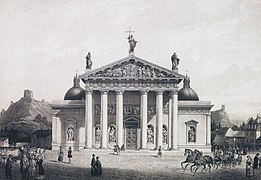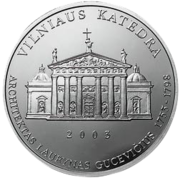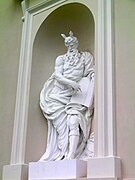Vilnius Cathedral
| Cathedral Basilica ofSt StanislausandSt Ladislaus | |
|---|---|
 Cathedral of Vilnius | |
| Religion | |
| Affiliation | Roman Catholic |
| Province | Archdiocese of Vilnius |
| Ecclesiastical or organizational status | Cathedral |
| Year consecrated | 1783 |
| Location | |
| Location | Vilnius, |
| Geographic coordinates | 54°41′09″N25°17′16″E/ 54.68583°N 25.28778°E |
| Architecture | |
| Type | Church |
| Style | Neoclassical |
| Groundbreaking | 1779 |
| Completed | 1783 |
| Website | |
| Cathedral Website | |
TheCathedral Basilica of St Stanislaus and St Ladislaus of Vilnius(also known asVilnius Cathedral;Lithuanian:Vilniaus Šv. Stanislovo ir Šv. Vladislovo arkikatedra bazilika;Polish:Bazylika archikatedralna św. Stanisława Biskupa i św. Władysława,historical:Kościół Katedralny św. Stanisława[1]) is the mainCatholiccathedral inLithuania.It is situated inVilnius Old Town,just offCathedral Square.Dedicated to theChristiansaintsStanislausandLadislaus,the church is the heart ofCatholic spiritual life in Lithuania.
History
[edit]

It is believed that in pre-Christian times, theBaltic pagangodPerkūnaswas worshipped at the site of the cathedral. It has also been postulated that the Lithuanian KingMindaugasordered the construction of the original cathedral in 1251 afterhis conversion to Christianityand appointment of a bishop to Lithuania. Remains of the archaic quadratic church with three naves and massivebuttresseshave been discovered underneath the current structure in the late 20th century.[2]After Mindaugas's death in 1263, the first cathedral again became a place of pagan worship.
In 1387, the year in which Lithuania was officiallyconverted to Christianity,construction began on a secondGothiccathedral with five chapels. This second cathedral, however, burnt down in 1419. During preparations for his 1429 coronation asKing of Lithuania,Vytautasbuilt a significantly larger Gothic cathedral in its place. Although the coronation never took place, the walls and pillars of this third cathedral have survived to this day. The third cathedral had three naves and four circular towers at its corners, andFlemishtravelerGuillebert de Lannoynoticed its similarity to theFrauenburgcathedral. In 1522, the cathedral was renovated, and a bell tower was built on top of theLower Castledefensive tower. After another fire in 1530, it was rebuilt again and between 1534 and 1557 more chapels and the crypts were added. The cathedral acquired architectural features associated with theRenaissance.
The coronations of theGrand Dukes of Lithuaniatook place within its confines. Inside its crypts and catacombs are buried many famous people fromLithuanianandPolishhistory includingVytautas(1430), his wifeAnna(1418), his brotherSigismund(Žygimantas) (1440), his cousinŠvitrigaila(1452),Saint Casimir(1484),Alexander Jagiellon(1506), and two wives ofSigismund II Augustus:Elisabeth of Austria(1545) andBarbara Radziwiłł(1551). The heart of the Polish king and Grand Duke of LithuaniaWładysław IV Vasawas buried there upon his death, although the rest of his body is buried at theWawel CathedralinKraków.
In 1529, the Crown Prince and future King of Poland, Sigismund II Augustus, was crowned Grand Duke of Lithuania in the cathedral. During theinaugurationsofLithuanian monarchsuntil 1569,Gediminas' Capwas placed on the monarch's head by theBishop of Vilniusin Vilnius Cathedral.[3]The demand of a separate inauguration ceremony of theGrand Duke of Lithuaniawas raised by the nobles of the Grand Duchy of Lithuania (e.g.Mikołaj "the Red" Radziwiłł,Eustachy Wołłowicz,Jan Karol Chodkiewicz,Konstanty Ostrogski) during the negotiations of theUnion of Lublin,however it was not officially included into it and the rulers of the Polish–Lithuanian Commonwealth were since then elected in theElection sejms.[4][5]Nevertheless, on 29 May 1580, bishopMerkelis Giedraitisin the Vilnius Cathedral presented Grand DukeStephen Báthory(King of Poland since 1 May 1576) aluxuriously decorated sword and a hat adorned with pearls(both were sanctified byPope Gregory XIIIhimself), while this ceremony manifested the sovereignty of the Grand Duchy of Lithuania and had the meaning ofelevationof the new Grand Duke of Lithuania, this way ignoring the stipulations of the Union of Lublin.[6][7][8][9]
After yet another fire in 1610, the cathedral was rebuilt again, and the two front towers were added. The cathedral was damaged again in 1655 when Vilnius fell to Russian troops in theRusso-Polish War of 1654–1667.It was renovated and redecorated several more times.

Between 1623 and 1636, at the initiative ofSigismund III Vasaand later completed by his son Wladyslaw IV Vasa, theBaroquestyleSaint Casimir chapelby royal architect Constantino Tencalla was built ofSwedishsandstone.Its interior was reconstructed in 1691–1692 and decorated with frescoes byMichelangelo Palloni,the altar andstuccoworkbyPietro Perti.This chapel contains sculpted statutes ofJagiellonkings and an epitaph with Wladyslaw IV Vasa's heart. More than anything in the Cathedral this chapel symbolizes the glory of Polish-Lithuanian union and common history.

In 1769 the southern tower, built during the reconstruction of 1666 collapsed, destroying the vaults of the neighbouring chapel and killing 6 people. After the damage,Bishop of VilniusIgnacy Jakub Massalskiordered the reconstruction of the cathedral. The works started in 1779 and were completed in 1783, and the interior was completed in 1801. The cathedral was reconstructed to its present appearance according to the design ofLaurynas Gucevičiusin theNeoclassicalstyle; the church acquired a strict quadrangular shape common to local public buildings. The main facade was adorned with sculptures of theFour Evangelistsby Italian sculptorTommaso Righi.Some scholars point to the architectural resemblance of the cathedral to the works ofAndrea Palladioor see the influence of Gucevičius's tutorClaude Nicolas Ledoux.[10]The influence ofPalladian architectureis evident in side facades of the building. The lack of 'purity' of the Classical architecture, due to incorporation of Baroque style sculptures and other elements, was later criticized by academical architects, notablyKarol Podczaszyński.

Between 1786 and 1792 three sculptures byKazimierz Jelskiwere placed on roof of the Cathedral -Saint Casimiron the south side,Saint Stanislauson the north, andSaint Helenain the centre. These sculptures were removed in 1950 and restored (sculptorStanislovas Kuzma) in 1997.[11][clarification needed]Presumably the sculpture of St. Casimir originally symbolized Lithuania, that of St. Stanislaus symbolized Poland, and that of St. Helena holding a 9 m-golden cross represents the true cross.[citation needed]
During theSoviet occupation,the cathedral was converted into a warehouse.Masseswere celebrated again starting in 1988, although the cathedral was still officially calledThe Gallery of Imagesat that time. In 1989, its status as a cathedral was restored. In January that year, the remains ofAlbertas Goštautaswere discovered in the cathedral wall.[12]
In 2002 work officially began to rebuild theRoyal Palace of Lithuaniabehind the cathedral. The newly erected palace building will considerably alter the context of the cathedral.
The cathedral and the belfry were thoroughly renovated from 2006 to 2008. The facades were covered with fresh multicolor paintwork, greatly enhancing the external appearance of the buildings. It was the first renovation since the restoration of Lithuania's independence in 1990.
In 2018, the cathedral’s tympanum and several of its plinths were repaired. In 2022, the roof was renovated after part of its was blown off by strong winds. In 2023, the roof lantern above St Casimir’s Chapel and the sacristy were repaired.[13]
Architecture
[edit]Inside, there are more than forty works of art dating from the 16th through 19th centuries, includingfrescoesand paintings of various sizes. During the restoration of the cathedral, the altars of a presumedpagantemple and the original floor, laid during the reign of KingMindaugas,were uncovered. In addition, the remains of the cathedral built in 1387 were also located. A fresco dating from the end of the 14th century, the oldest known fresco in Lithuania, was found on the wall of one of the cathedral's underground chapels.
Gallery
[edit]-
The fresco in the Vilnius Cathedral, dating to theChristianization of Lithuania
-
Façade of Vilnius Cathedral in a 1847 drawing
-
The Bell Tower
-
Litascoin to commemorateVilnius Cathedral
-
Side view of Vilnius Cathedral
-
Façade view of the Vilnius Cathedral at night
-
Statue of apostleMark
-
Statue of apostleMatthew
-
Statue of apostleLuke
-
Statue ofMoses
-
Cartouche on the wall of St. Casimir's Chapel in Vilnius. West wall of Vilnius Cathedral
-
Bas-relief of Vilnius Cathedral
References
[edit]- ^Kirkor, Adam Honory (1880).Przewodnik po Wilnie i jego okolicach(2nd ed.). Nakładem i drukiem Józefa Zawadzkiego. pp. 72, 102.
- ^Mindaugas's Cathedral according to archaeological data
- ^Gudavičius, Edvardas."Gedimino kepurė".Visuotinė lietuvių enciklopedija(in Lithuanian).Retrieved19 March2023.
- ^Jasas, Rimantas."Liublino unija".Visuotinė lietuvių enciklopedija(in Lithuanian).Retrieved6 November2023.
- ^Tyla, Antanas."Elekcinis seimas".Visuotinė lietuvių enciklopedija(in Lithuanian).Retrieved6 November2023.
- ^"Vavelio pilies lobyne – ir Lietuvos, Valdovų rūmų istorija".Palace of the Grand Dukes of Lithuania(in Lithuanian).Retrieved6 November2023.
- ^Bues, Almut (2005)."The year-book of Lithuanian history"(PDF)(in Lithuanian). Lithuanian Institute of History: 9.Retrieved6 November2023.
{{cite journal}}:Cite journal requires|journal=(help) - ^Stryjkowski, Maciej (1846).Kronika polska, litewska, żmódzka i wszystkiéj Rusi Macieja Stryjkowskiego. T. 2(in Polish). Warsaw. p. 432.Retrieved6 November2023.
- ^Ragauskienė, Raimonda; Ragauskas, Aivas; Bulla, Noémi Erzsébet (2018).Tolimos bet artimos: Lietuvos ir Vengrijos istoriniai ryšiai(PDF)(in Lithuanian). Vilnius. p. 67.Retrieved6 November2023.
{{cite book}}:CS1 maint: location missing publisher (link) - ^[1]Archived27 February 2008 at theWayback Machine
- ^"Vilniaus arkikatedra".Ldmuziejus.mch.mii.lt. 27 March 2006. Archived fromthe originalon 7 January 2007.Retrieved7 January2012.
- ^Jankauskas, Rimantas."LDK istorija: Vilniaus vaivados ir LDK kanclerio Alberto Goštauto kūno antropologinis tyrimas".15min.lt(in Lithuanian).Retrieved12 September2021.
- ^Narkunas, Vilius."Vilnius Cathedral needs renovation, but who should pay?".LRT.Retrieved27 May2024.
- Roman Catholic churches completed in 1783
- 18th-century Roman Catholic church buildings in Lithuania
- Roman Catholic cathedrals in Lithuania
- Basilica churches in Lithuania
- Rebuilt buildings and structures in Lithuania
- Roman Catholic churches in Vilnius
- Burial sites of the Gediminids
- Burial sites of the Jagiellonian dynasty
- Burial sites of the House of Radziwiłł
- Burial sites of the House of Vasa
- Objects listed in Lithuanian Registry of Cultural Property
- Neoclassical church buildings in Lithuania
- Landmarks in Vilnius












